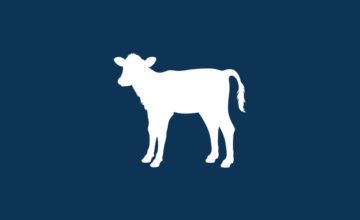Calf Starter for VG Program
- Mar 30, 2009
- By Grober Nutrition
- In Canada
The calf starter ration, to compliment grain veal program, needs to be highly palatable and of excellent quality. When a high protein milk replacer (21%) is being fed, the calf starter should be at least 18-20% protein to maintain optimal growth. It is critical that protein needs must be met to help maintain early growth rate advantage. In raising calves, the major goals of feeding before weaning are to:
- Feed for optimum health and strong immunity
- Have good skeletal development
- Encourage the intake of starter
- Develop rumen activity
- Prepare the calf for weaning
Restricted feeding can impair the immune system. (Kelly, 1980) To help prevent the weaning stall out, reduce the volume of liquid being fed to achieve a starter intake of 900 grams per calf per day, for 3 consecutive days prior to weaning. A calf should not be weaned until its rumen is functional and capable of supporting all of its nutritional needs. Normal and early development of the rumen requires:
- 1. Bacteria
- 2. Liquid in the rumen
- 3. Absorptive ability of rumen wall tissue
Bacteria
Bacteria begin to grow in the rumen as soon as the calf begins to eat. The types of bacteria that develop are dependent on the type of feed that the calf eats. Milk supports aerobic bacteria development, while dry feed supports anaerobic bacteria. It is anaerobic bacteria that are necessary for proper rumen development and function.
Liquid in the Rumen
Bacteria in the rumen can only survive in a water environment. Most of the water that enters the rumen is from free water intake. Milk or milk replacer does not constitute free water. They bypass the rumen due to the esophageal groove that is active until 12 weeks of age. The intake of water stimulates dry feed intake, thus the availability of clean fresh water is critical to dry matter intake and overall calf health and performance. Typically, a 180kg calf consumes 10-30 litres of water daily depending on temperature, humidity and dry matter of the diet. Effect of free choice water on calf performance
| Effect of free choice water on calf performance | (Water) Free Choice | (Water) None |
| Daily gain (grams) | 309 | 180 |
| Calf starter intake (kg) | 11.8 | 8.18 |
| Scour days per calf | 4.5 | 5.4 |
Kertz, A.F. 1984 J.D.S. 67: 2964-2969
Absorptive Ability of Rumen Wall Tissue
The absorption of end products of fermentation is a very important part of rumen development. The energy requirements of the newborn calf are met from absorption of glucose from the abomasum. There is little or no absorption or metabolism of volatile fatty acids (VFA) in neonatal calves. The rumen must develop this ability prior to weaning. The rumen consists of two layers, the epithelial layer and the muscular layer. The muscle layer is responsible for rumen contractions and gives support to the epithelial layer. The epithelial layer of the rumen wall is the absorptive layer. End products (VFA) of ruminal fermentation, particularly propionate and butyrate, provide the stimulus needed for epithelial development. Calves denied access to dry feed will not develop a functional rumen. It is grain intake rather than hay/straw intake that is important to ensure rapid rumen development and a smooth transition at weaning time. Calf time line and rumen development
| Calf time line | |||
| Diet | Liquid | Liquid+Solid | Solid |
| Organ* | Abomasun | Abo+ Rumen | Rumen |
| Energy** | Glucose | Glucose/VFA | VFA |
| Protein** | Dietary | Diet/Bacteria | Bacteria |
*Primary organ, ** Primary nutrient weaning
General Guidelines
- A good quality palatable starter (min 18% protein) should be offered from day 5.
- Feed to appetite, with frequent fresh ‘top ups’, is preferable to ad lib feeding.
- Calves prefer to have calf starter in a shallow bowl, one in which they can scrape their tongues under the grain. They consume more starter when they are able to reach the bottom of the container. Deep containers are less attractive to calves as accumulated feed becomes spoiled with saliva and calves find it physically more challenging to get at the feed.
- All buckets and containers should be emptied and cleaned daily.
- Calves should not be weaned until they are eating 900 grams of starter per day for 3 consecutive days.
- Calf starter with considerable molasses may freeze in winter into frozen lumps and may clump in the hot humid summer months.
- Calf starter with excessive molasses may attract flies in the summer.
- Pelleted calf starter may crumble. Fines from old pelleted calf starter are especially unpalatable for calves. Pelleted calf starters are excellent feeds, but it becomes very important for daily replenishment.
- Ensure adequate fresh, clean water is available.
Grober Nutrition
Recent Posts
Tags
Archives
- October 2024
- July 2024
- May 2024
- April 2024
- January 2024
- December 2023
- October 2023
- September 2023
- August 2023
- June 2023
- December 2022
- November 2022
- October 2022
- August 2022
- July 2022
- June 2022
- May 2022
- April 2022
- March 2022
- February 2022
- January 2022
- August 2021
- February 2021
- September 2020
- June 2020
- April 2020
- May 2017
- April 2017
- October 2016
- September 2016
- August 2016
- March 2016
- March 2015
- January 2015
- December 2014
- December 2013
- September 2013
- May 2013
- January 2013
- December 2012
- November 2012
- March 2012
- March 2011
- February 2011
- November 2010
- August 2010
- December 2009
- November 2009
- March 2009







